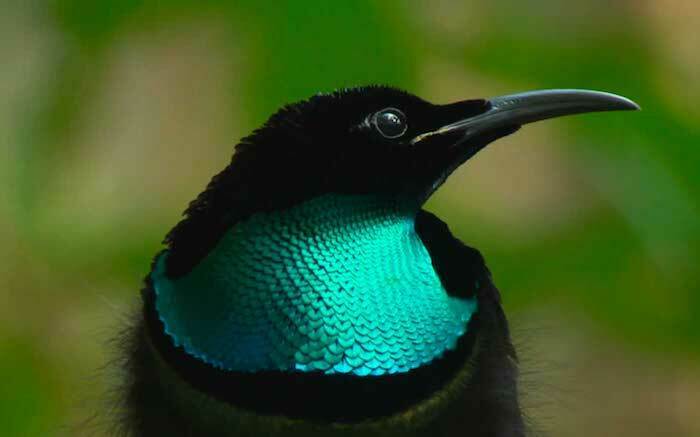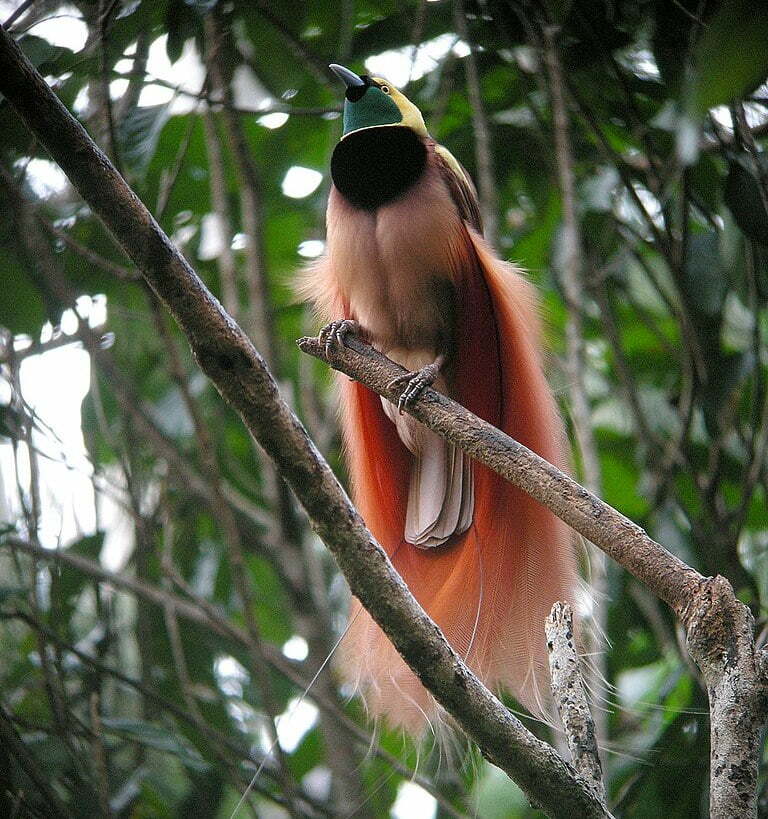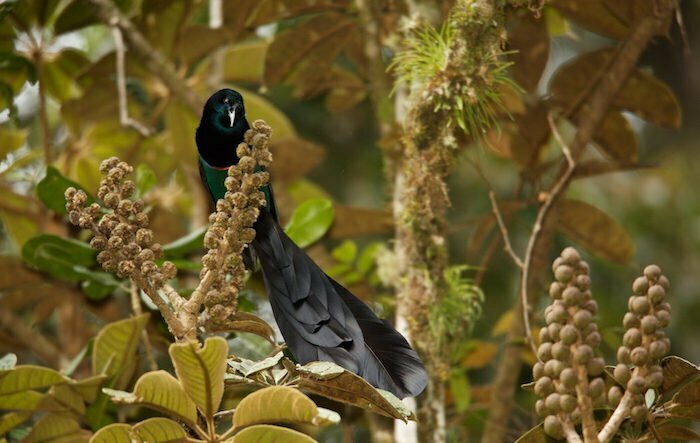Papua New Guinea is a birdwatchers mecca and with 38 of the 43 known species of Birds of Paradise found here it is no wonder why.
Imagine cruising around this remote region on a private luxury charter which allows you to take in the marine wonders and the spectacular birding opportunities in one phenomenal trip.
Here are 5 of our favourite (and most stunning looking) species of birds of paradise which can be found in Papua New Guinea:
The magnificent riflebird is a medium-sized species (up to 34 cm long). The male is velvet-black bird-of-paradise with elongated black filamental flank plumes, an iridescent blue-green crown, a wide, triangle-shaped breast shield, and on central tail feathers. It has a black curved bill, yellow mouth, blackish feet and a dark brown iris. The female is brownish with dark spots and buff bars below with a white brow. The immature male resembles the male but with less tail plumes.

Probably the most famous of the birds of paradise in Papua New Guinea is the Raggiana (Paradisaea raggiana which is the countries national emblem and appears on the national flag. This bird of paradise is known by the local people as “kumul” which is also the nickname of Papua New Guinea’s national rugby team.


The Raggiana bird of paradise is 34 centimetres (13 in) long. Its overall colour is a maroon-brown, with a greyish-blue bill, yellow iris and greyish-brown feet. The male has a yellow crown, dark emerald-green throat and yellow collar between the throat and its blackish upper breast feathers. It is adorned with a pair of long black tail wires and large flank plumes. The male has the long tail feather while the female does not. The female is a comparatively drab maroonish-brown bird. The ornamental flank plumes vary from red to orange in color, depending on subspecies.


Looking for the Raggiana birds of paradise is an exciting experience and, as with many of these birds, you’ll make treks through lush tropical rainforest where local tribal communities still live as they have done for centuries.
Another species, which is endemic to Papua New Guinea, are the Goldie’s birds of paradise (Paradisaea decora). This species was named after the collector, Andrew Goldie, who first discovered the bird in 1882.


Goldie’s birds of paradise are approximately 33 cm long and have an olive-brown colouration. The male has a yellow and dark green plumage with a lavender grey breast, yellow iris and grey coloured bill, mouth and feet. It is adorned with large crimson ornamental flank plumes and two long tail wires. The male is distinguished from other species of birds of paradise by its lavender grey breast plumage. The unadorned female has an olive-brown plumage which is chestnut brown below.
A sighting of a Goldie is an extremely special moment as this species is now listed on the IUCN red list.
The ribbon-tailed astrapia, also known as Shaw Mayer’s astrapia (Astrapia mayeri) is the most recently discovered o fthe birds of paradise but there is some controversy over who and when first made the discovery! The species was thought to have been discovered by Fred Shaw Mayer in 1938, however, it is now believed that explorer Jack Hides discovered the bird and Mayer became interested in it later.


The ribbon-tailed astrapia is medium-sized, up to 32 cm long (without including the tail of the male, which can be over 1 metre). Male ribbon-tailed astrapia are generally around 125 cm whereas females are around 35 cm. The body of males are velvet black. The male has an iridescent olive green and bronze plumage, and is adorned with ornamental “ball” plume above its bill and two extremely long, ribbon-like white tail feathers. The female has a much duller brown and black body with an iridescent head. Unlike males, females do not have the long white tails.
The male of this species has the longest tail feathers in relation to body size of any bird, over three times the length of its body.


Due to habitat loss and being hunted for its plumes, the Ribbon-tailed Astrapia is listed as Near Threatened on the IUCN Red List of Threatened Species. The long tail which is characteristic of the males, also makes is difficult for the bird to escape natural predators.


The Huon astrapia (Astrapia rothschildi) is a little known bird-of-paradise, which is endemic to Papua New Guinea and feeds on a diet which consists mainly of fruits and seeds.
The Huon astrapia is a medium-sized bird of paradise at approximately 69 cm long. The male has black plumage with a glossy blue crown, dark olive-green back, iridescent purple-green elongated nape feathers, and a very long and broad purplish black tail. The female is smaller than male, and has blackish-brown plumage with pale barring on its abdomen.
Would you like to see these stunning species of birds of paradise in the natural habitat in Papua Guinea? A birding expedition to Papua New Guinea is like no other. The region is awash with tribal culture, pristine coral reefs, vibrant locals and some of the most exotic flora and fauna on the planet.
A private charter on board El Aleph assures you total luxury from start to finish and you’ll be able choose your cruising route to take in all that you want to see. Our dedicated and experienced crew are there to ensure that your private charter is everything you dreamed of and more – whether you want a candle lit dinner on a virgin, white sand beach or a family barbecue with cocktails under the stars – we’ll make it happen.


El Aleph is fully equipped with sea kayaks, snorkeling and scuba diving equipment, donut ring, bodyboard, water ski’s and more, so in between birding (or for non-birding members of your group), there is always plenty to do on board and in the water. For those who want to take the cruise at a more relaxed pace there is nothing better than watching the tropical landscape pass by in this incredible region that really does take you off the grid.
To make a reservation or enquiry, please contact us on info@elalephcruising.com.
Please note that for your comfort, luxury and privacy we only take bookings for full charters and not for private cabins.


